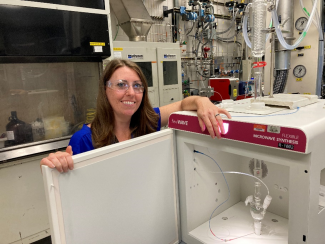A pair of microwave reactors recently installed at NETL provides researchers with tools to quickly screen materials called catalysts for their potential to trigger the chemical reactions needed to convert carbon dioxide (CO2) into useful chemicals and decarbonize industrial processes that emit greenhouse gas.
“Developing effective catalysts for use in microwave-based reaction science has been a time-consuming, trial-and-error process,” said NETL’s Christina Wildfire. “Using these new capabilities, our researchers will be able to expedite proof-of-concept testing and identify catalysts that look promising for further development and eliminate those that do not.”
NETL’s microwave catalysis (MCAT) unit and the microwave synthesis (MWS) unit are up and running at the Lab’s research campus in Morgantown, West Virginia, which is also home to NETL’s Reaction Analysis and Chemical Transformation (ReACT) facility.
The only facility of its kind in the world, ReACT explores the use of breakthrough technologies, such as microwaves and other non-traditional energetics, to advance reaction science.
A chemical reaction is a process that leads to the chemical transformation of one set of chemical substances to another. Identifying the best catalysts to reduce the energy needs and lower a process’s carbon footprint to produce a useful product is a major research focus at NETL. The best catalysts are those that increase the rate of chemical reactions but are not consumed in the process and can be used repeatedly.
Conventional heating works from the outside in, while microwaves provide rapid, selective heating on a molecular scale. Microwaves are advantageous because they allow researchers to achieve a desired temperature for their studies in seconds, which minimizes startup and shutdown times and saves energy. Using microwaves, researchers can also target just the catalyst or reacting species, which improves product distribution and selectivity while reducing the reactor size.
Microwave technology is a key component in meeting the Biden Administration’s climate change goals, which call for a 100% carbon pollution-free electricity sector by 2035 and a net-zero-carbon economy by 2050.
“One of the benefits of the MCAT and MWS units is the ability to complete small, bench-scale studies so that the ReACT facility is focused on advanced studies at larger scales,” said Wildfire, a researcher on the Lab’s Reaction Engineering Team.
The MCAT and MWS units are being used by Wildfire and her colleagues in several cutting-edge research projects.
One study is focused on reducing CO2 emissions created in the ironmaking process by replacing carbon-based material to reduce the iron with clean hydrogen and microwaves as a green heating source.
The direct reduced iron (DRI) method, which uses hydrogen instead of coke (carbon-based reducing material), is a promising method for decarbonizing iron production. However, in the existing DRI process, long processing times are needed, and hydrogen is typically produced using a CO2-intensive methane reforming process.
Bench-scale testing using the Lab’s new equipment, a project led by NETL principal investigator Ranjani Siriwardane, is investigating if a process assisted by microwave technology can be used to accelerate the processing times and use biomass as the hydrogen source to achieve a deep level of decarbonization.
Another study is examining polycarbonate diols, important raw materials to produce polyurethanes, which have numerous applications in aerospace, agriculture, automotive, manufacturing and material handling industries. However, the production process uses toxic chemicals such as phosgene gas and dichloromethane.
NETL researchers are evaluating the application of microwave technology to generate polycarbonates from CO2. “Initial results have shown that the microwave process with CO2 can achieve similar polycarbonate yields, and NETL researchers are currently evaluating the application of microwave technology to make this more benign process viable,” Wildfire said.
Researchers found the microwave selectively heated the reaction mixture, thereby improving energy efficiency. If successful, the process provides a more simplified route to produce sustainable chemicals using waste CO2 sources with lower energy requirements compared to the existing process.
“The need for cleaner industrial processes to make iron and polyurethanes are real-word problems. At NETL, we are working to address them using microwave technology to provide highly efficient, energy-saving solutions,” Wildfire said.
NETL is a U.S. Department of Energy national laboratory that drives innovation and delivers technological solutions for an environmentally sustainable and prosperous energy future. By using its world-class talent and research facilities, NETL is ensuring affordable, abundant, and reliable energy that drives a robust economy and national security, while developing technologies to manage carbon across the full life cycle, enabling environmental sustainability for all Americans.




